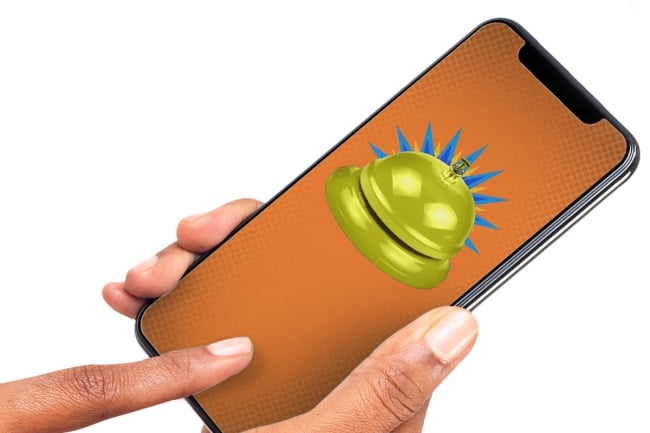You have /5 articles left.
Sign up for a free account or log in.

GSU’s nudges were sent by a chat bot via text messages.
Photo illustration by Justin Morrison/Inside Higher Ed | hayatikayhan/iStock/Getty Images | Teddy/rawpixel
“Hi [name]. My friends in Financial Aid indicate that you still have a balance to your account for fall term. The payment deadline is Friday. To avoid any disruption in your enrollment, you can pay your balance at [link]. If you need help in covering your bill, please reach out to [link].”
It’s a simple message that researchers say made a sizable difference in whether students on two Georgia State University campuses resolved their financial balances on time; of the 374 students with outstanding balances who received the notification, 31 percent paid the balance, compared to only 22 percent of those who didn’t receive a notification.
The results, revealed in a new working paper from the National Bureau of Economic Research Monday, are the latest to support the effectiveness of nudges—small, inexpensive interventions deployed to influence people’s decisions—in higher education.
Nudges, which were popularized in the 2008 book Nudge: Improving Decisions About Health, Wealth, and Happiness, are somewhat controversial. In recent years, critics have argued that research broadly points to their ineffectiveness, while others acknowledge that they can be helpful but are not the panacea some supporters claim them to be. Research published in 2019 by Philip Oreopoulos and Uros Petronijevic on nudging in higher education seemed to come to the latter conclusion; nudging had helped students with certain objectives, the researchers said, but didn’t affect students’ grades.
The Georgia State study, by researchers Lindsay C. Page of Brown University, Katharine E. Meyer of the Brookings Institute, Jeonghyun Lee of Georgia Tech and Hunter Gehlbach of Johns Hopkins University, walks a middle ground. It argues that some nudges are significantly effective—but that not all nudges are equal. Though many kinds of nudges deployed in the study had some impact on student behavior, one type proved the most effective: those sent to a specific group of students encouraging them to complete a timely or high-stakes task. Those included verifying information on their FAFSAs, resolving course registration holds and attending coaching for students with low grade point averages.
“This kind of proactive outreach is effective at helping students, particularly when the tasks the messaging focuses on are sort of acute tasks that students need to take care of in order to remain in good standing,” said Page, who has studied nudges in higher education for more than a decade.
The reminders were sent by a GSU chat bot, which the university first developed in 2016 to reduce summer melt by signaling to students when they still had to pay fees, submit immunization records, finish their FAFSAs or complete other tasks before they could matriculate. Students receive text messages on their phones and can respond with questions, some of which the bot is programmed to answer itself and some of which it forwards to human “friends.”
The technology proved so successful with incoming students—it lowered summer melt by 20 percent in the first year—that the university expanded it to current students, according to Tim Rennick, the founding executive director of GSU’s National Institute for Student Success.
A Range of Effectiveness
Some of the messages had more impact than others. Nudges sent to all or most students, like one encouraging them to register for classes, for example, were somewhat effective; nudged students at GSU-Atlanta were about three percentage points more likely than the control group to register for fall classes by mid-June. But messages targeted toward a specific group of students had a bigger impact on behavior; for instance, nudging those with unpaid balances improved the completion rate by nine percentage points over the control group. Meanwhile, messages encouraging students to complete lower-stakes tasks, like attend a career fair, seemed to have no impact on the recipients’ behavior.
The results confirm what the NISS staff has observed since the chat bot’s deployment in 2016.
“Early on, we found that the tool was more helpful for helping the students compete their verification requests for financial aid than it was for helping them choose a major,” Rennick said. “They’re time-sensitive; they tend to be technical in nature.”
The study also noted that in some cases the timing of the nudges was important; a series of nudges about completing the FAFSA sent over multiple months was most impactful in the first month, for example.
Anecdotally, Page noted that GSU’s chat bot supports the theory that nudges are especially useful when they come from an entity the students trust—in this case, Pounce, GSU’s blue panther mascot. But it could also mean a recognizable administrator or staff member, rather than, say, a government official, she said. The communications are also personalized, identifying the student by name in each message.
“What I have observed across a body of studies is when there is not that relationship between the student and the sender, students are more likely to unsubscribe from the messages … and are less likely to see positive effects,” she said.
Another benefit of the chat bot not specifically studied in the research was its two-way communications; Rennick said the bot’s ability to respond to questions has been a boon for students, who are often too busy to seek in-person help during working hours. He’s seen conversations between students and the sophisticated bot—which is capable of walking them through every question on the FAFSA, for example—go on for as many as 20 messages.
“The use of the tool is heavier at 12 midnight than nine in the morning,” he said. “It’s not just these students are getting a quick question answered; it’s the only time they have available to complete the FAFSA … At that time in the night, there’s nobody available to deal with the problem live.”
The university now plans to take the information gleaned in this study a step further and apply it to certain courses—specifically, large first- and second-year classes with low grades and high rates of withdrawal, Rennick said. The course-specific chat bots, designed in partnership with the classes’ instructors, will provide nudges on things like upcoming deadlines and quizzes and will even offer to send practice quiz questions.
He believes the tool will be especially useful to students who don’t have time to attend office hours or tutoring sessions, as well as students who might be struggling to get a handle on time management and studying early in their college careers.
“There are multiple ways in which college life can be highly stressful,” he said, “and there’s a lot more expertise needed to navigate college than we sometimes think.”
Page acknowledged that colleges can’t “nudge every student to success” but argued that her team’s research shows they can make a difference in students’ lives and outcomes.
“Nudges aren’t going to save the world—they aren’t the answer to everything and, in fact, even when they’re effective, they’re not solving the problem for everybody … but they do have their place,” she said. “Done in particular ways and [for] particular tasks, they can be helpful and they can be effective. So, we should be thinking about how, when and what we communicate to students, and how this communication strategy can be effective when targeting particular types of behaviors.”




